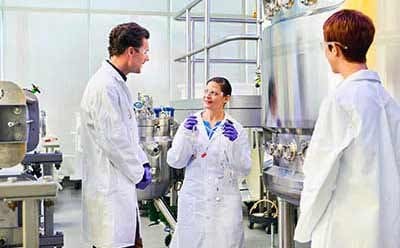Removing Viruses From Your Downstream mAb Process

Downstream processing in the production of monoclonal antibodies (mAb) reduces the levels of virus by either removal or inactivation. Regardless of the technology, biomanufacturers must demonstrate the clearance capabilities of different downstream steps as part of the viral safety assessment process.
Downstream processing typically includes:
- Chromatography – virus removal by binding affinity, charge or hydrophobicity
- Chemical treatment – virus reduction by inactivation
- Filtration – virus removal by size exclusion, a critical step for viral safety in most downstream processes
- Demonstrating Effectiveness
Related Articles
- Viral safety in bioprocessing relies on a framework of (1) preventing contamination, (2) detecting contamination, and (3) removing or inactivating viral contaminants.
- Preventing adventitious viruses in bioreactors is crucial; manufacturers implement upstream measures to safeguard biotherapeutic manufacturing.
- Molecular testing enhances biomanufacturers' viral safety compliance and speed to results for raw materials and intermediates.
- Monoclonal antibody manufacturing requires scalable solutions ensuring high therapeutic concentration and process safety for immunotherapy.
- Continued process verification is critical to maintain the strength, quality, and purity of the final drug product. It is a regulatory expectation as manufacturers are instructed to ensure their process remains in a continual state of control. Learn more in this technical article.
- This application note describes the benefits and performance of Cellvento® 4CHO-X Expansion Medium designed for multiple cell expansion steps from vial thaw to N-1 stages to generate higher biomass for inoculating fed-batch production bioreactors
- The accelerated mAb development program delivers GMP drug substance nine months from transfection. We designed the mAbExpress™ program to be fast, cost effective, and appropriate for the early clinical phase of your program, with regulatory support throughout.
- The performance of membrane adsorbers for antibody purification is compared to quaternary amine resins, membranes, and salt-tolerant primary amine membranes.
- See All (6)
Find More Articles and Protocols
Chromatography
To reach viral clearance targets, most downstream processes include at least two chromatography operations. A typical solution is protein A capture, followed by ion exchange chromatography (IEX), comprised of cation exchange chromatography (CEX) to reduce antibody aggregate levels and anion exchange chromatography (AEX) to remove residual host cell proteins and DNA. Under select conditions, both CEX and AEX can contribute to viral safety.
Chemical Treatment
Chemicals used for virus inactivation must meet the same high-quality standards as other raw materials. Selected chemicals should be manufactured or purified to GMP standards (based on the IPEC – PQG GMP guide for pharmaceutical excipients, 2006) for consistent high purity in order to assure process reliability. Chemicals with comprehensive testing and documentation packages simplify the compliance process.
Filtration
Removal of virus by filtration is typically based on size, with most mAb production processes relying on filtration to provide high levels of both enveloped and non-enveloped virus reduction. Virus filtration is regarded as a robust step for virus removal and is relatively insensitive to process conditions. However, the presence of protein aggregates and other trace fouling species can negatively impact the throughput performance of virus filters, resulting in increased filtration area requirements. For greater filtration efficiency, a prefiltration step to remove fouling species may be incorporated, leading to significant improvements in virus filter capacity, flux, and overall viral filtration costs.
Demonstrating Effectiveness
Manufacturers of biologics are required to evaluate their downstream manufacturing process for the ability of selected unit operations to inactivate or remove potential contaminants. Results of such clearance studies are required by regulatory authorities for investigational new drug (IND) submissions. Understanding these regulatory expectations is a key component of clearance study design, informing the manufacturer’s overall viral safety strategy.
Workflow


Detecting viral contamination
Testing for the presence of viruses and other adventitious agents in cell banks, raw materials, and process intermediates.

Monoclonal Antibody Manufacturing
Monoclonal antibody manufacturing is a highly templated approach used to produce mAb-based immunotherapies. Robust, scalable process solutions are required at every step to ensure high therapeutic concentration and process safety, while meeting speed-to-market and cost containment concerns.
Related Webinars
Our head of project management discusses preparing for a viral clearance study from the client perspective with a technical specialist.
Learn how prefiltration technologies can significantly increase the performance of your viral clearance filter.
This presentation describes a case study using Viresolve® Pro membrane filters where virus retention performance is characterized following process interruptions.
In this webinar, you will learn how to simplify validation study design, identify critical processes and feed parameters affecting virus retention, and compile a robust regulatory filing package.
Related Resources
- Article: Viral Clearance in Antibody Purification Using Tentacle Ion Exchangers
- Poster: Virus Clearance Using Eshmuno HCX
- Poster: Efficient Virus Clearance Across Downstream Purification Portfolio
- Poster: Enhancing Virus Filter Performance with the Use of Adsorptive Depth or Surface Modified Prefilters
- Brochure: Vmax Constant Pressure Test for Sizing Viral Clearance Filters
- Article: Impact of Process Interruption on Virus Retention of Small-virus Filters
- Article: Fundamental Strategies for Viral Clearance - Part 1: Exploring the Regulatory Implications
- Article: Fundamental Strategies for Viral Clearance Part 2: Technical Approaches
- Viral Safety in Bioprocessing
Viral safety in bioprocessing relies on a framework of (1) preventing contamination, (2) detecting contamination, and (3) removing or inactivating viral contaminants.
To continue reading please sign in or create an account.
Don't Have An Account?